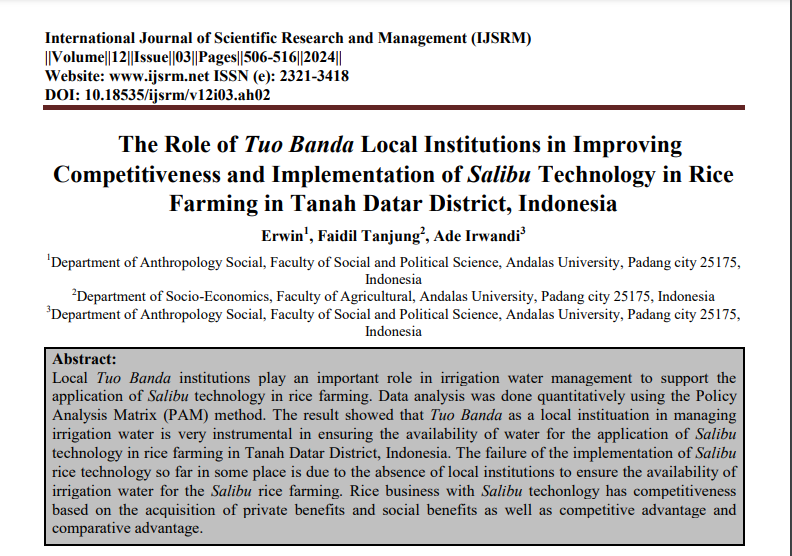The Role of Tuo Banda Local Institutions in Improving Competitiveness and Implementation of Salibu Technology in Rice Farming in Tanah Datar District, Indonesia

Submission to VIJ 2024-03-21
Keywords
- Competitiveness,
- Tuo Banda Local Institution,
- Policy Analysis Matrix,
- Salibu Rice Farming
Copyright (c) 2024 Erwin, Faidil Tanjung, Ade Irwandi

This work is licensed under a Creative Commons Attribution 4.0 International License.
Abstract
Local Tuo Banda institutions play an important role in irrigation water management to support the application of Salibu technology in rice farming. Data analysis was done quantitatively using the Policy Analysis Matrix (PAM) method. The result showed that Tuo Banda as a local institution in managing irrigation water is very instrumental in ensuring the availability of water for the application of Salibu technology in rice farming in Tanah Datar District, Indonesia. The failure of the implementation of Salibu rice technology so far in some places is due to the absence of local institutions to ensure the availability of irrigation water for Salibu rice farming. Rice business with Salibu technology has competitiveness based on the acquisition of private benefits and social benefits as well as a competitive advantage and comparative advantage.
References
- Baga LM, Utami AD, Wahyudi AF. Exploring the Relation between Farmer Group Membership and Agricultural Productivity: Evidence from Indonesian Rice Farming. Agrar J Agribus Rural Dev Res. 2023;9(1):65-78. doi:10.18196/agraris.v9i1.115
- Helmy E, Sulistyowati L, Noor TI, Setiawan I. Economic Efficiency of Rice Farming: A Performance Difference among Agricultural Insurance Participant and Non-participant Farmer. Agrar J Agribus Rural Dev Res. 2023;9(1):30-47. doi:10.18196/agraris.v9i1.108
- Herdiyanti H, Eko Sulistyono, Purwono. Pertumbuhan dan Produksi Beberapa Varietas Padi (Oryza sativa L.) pada Berbagai Interval Irigasi. J Agron Indones Indones J Agron. 2021;49(2):129-135. doi:10.24831/jai.v49i2.36558
- Porter ME. The Competitive Advantage of Nations. 10. [pr.], new ed. with updates in an introduction by the author 1998. Macmillan; 1998.
- Badan Litbang Pertanian. Panduan Teknologi Budidaya Padi Salibu. Published online 2015.
- Aminah A, Andriyani D. ANALISIS EFISIENSI KEUNTUNGAN USAHATANI PADI SAWAH DENGAN TEKNIK TANAM PINDAH DAN TEKNIK TANAM BENIH LANGSUNG DI KAMPUNG ALUE JANGAT KECAMATAN DARUL IHSAN KABUPATEN ACEH TIMUR. J Ekon Pertan Unimal. 2020;3(1):1. doi:10.29103/jepu.v3i1.3173
- Adji R. Teknologi Budidaya Padi Salibu Sebagai Metode Peningkatan Produksi Padi. President University Press; 2023.
- Fitri R, Erdiman, Kusnadi N, Yamaoka K. SALIBU technology in Indonesia: an alternative for efficient use of agricultural resources to achieve sustainable food security. Paddy Water Environ. 2019;17(3):403-410. doi:10.1007/s10333-019-00735-0
- Marpaung DSS, Anika N, Bindar Y. Strategi Peningkatan Produktivitas Padi melalui Sistem Salibu. J Sumberd Lahan. 2022;16(1):1. doi:10.21082/jsdl.v16n1.2022.1-7
- Surdianto Y. KINERJA TEKNOLOGI BUDIDAYA PADI SALIBU DI LAHAN SAWAH IRGASI KABUPATEN CIANJUR. Creat Res J. 2019;5(02):75. doi:10.34147/crj.v5i02.220
- Hafid K, Widiarta IN, Gunawan A, Muazam A. Salibu Rice Cultivation in Tungro Endemis Region. J Tek Pertan Lampung J Agric Eng. 2023;12(2):338. doi:10.23960/jtep-l.v12i2.338-349
- Mayly S, Syafri A. Implementation of Salibu Rice Cultivation Technology in Percut Sei Tuan Sub-District. J Saintech Transf JST. 2018;1(1):33-40.
- Pasaribu PO, Triadiati, Anas I. Rice Ratooning Using the Salibu System and the System of Rice Intensification Method Influenced by Physiological Traits. Pertanika J Trop Agric Sci. 2018;41(2):637-654.
- Putra IBGYJ, Sudibia IK. PENGARUH MODAL, TENAGA KERJA, TEKNOLOGI DAN LUAS LAHAN TERHADAP PRODUKSI DAN PENDAPATAN PETANI KOPI DI KECAMATAN KINTAMANI. J Ilm Manaj Ekon Akunt MEA. 2023;7(3):399-415. doi:10.31955/mea.v7i3.3370
- Sakti MBG, Komariah K, Ariyanto DP, Sumani S, Zaki MK, Noda K. The comparison between conventional and rice ratoon system on soil properties, rice productivity and nutrient status. SAINS TANAH - J Soil Sci Agroclimatol. 2021;18(1):65. doi:10.20961/stjssa.v18i1.47553
- Haryanto LI, Masyhuri M, Irham I. The Policy Analysis Matrix in Measuring Competitiveness of Maize Farming System in Marginal Areas. Agro Ekon. 2019;29(2):244. doi:10.22146/ae.35964
- Priyanka PA, Chandrasekaran M, Nandakumar E. Policy analysis matrix approach: Applications, strengths and weaknesses. Agric Res J. 2015;52(3):11. doi:10.5958/2395-146X.2015.00029.0
- Pearson S, Gotsch C, Bahri S. Aplikasi Policy Analysis Matrix Pada Pertanian Indonesia. 1st ed. Yayasan Obor Indonesia; 2005.
- Reig E, Picazo-Tadeo AJ, Estruch V. The policy analysis matrix with profit-efficient data: evaluating profitability in rice cultivation. Span J Agric Res. 2008;6(3):309. doi:10.5424/sjar/2008063-324
- Van Zyl J. The policy analysis matrix for agricultural development, By Eric A Monke & Scott R Pearson, Cornell University Press, Ithaca and London, 1989. Dev South Afr. 1990;7(1):133-140. doi:10.1080/03768359008439507
- Cernea MM. Mengutamakan manusia di dalam pembangunan: variabel-variabel sosiologi di dalam pembangunan pedesaan. Cet. 1. Penerbit Universitas Indonesia; 1988.
- Yamaoka K, Erdiman, Htay KM, et al. Unprecedented and Sustainable High-Yield Rice-Ratooning with the Lowest Use of Time and Resources SALIBU Rice Ratoon Cropping Systems Perennial Rice Cultivation Using Low-Position Ratoons. JIRCAS Japan International Research Center for Agricultural Sciences; 2023.
- Wahyuni S, Zulvera Z, Tanjung HB, Arif E. Hubungan Karakteristik Inovasi dan Kearifan Lokal Terhadap Keberlanjutan Penerapan Teknologi Padi Salibu di Kabupaten Tanah Datar, Sumatera Barat. J Penyul. 2019;15(1). doi:10.25015/penyuluhan.v15i1.21237
- Dewi IANU. Pengaruh Modal, Tenaga Kerja, Dan Luas Lahan Terhadap Jumlah Poduksi Kopi Arabika Di Kecamatan Kintamani Kabupaten Bangli. Skripsi. Universitas Udayana; 2017. https://sinta.unud.ac.id/uploads/dokumen_dir/5628ecb40fb943baeb40a4632aeb8057.pdf
